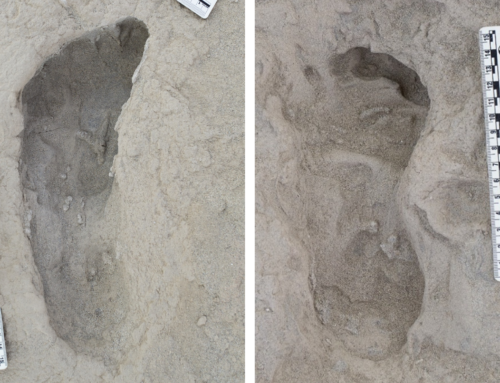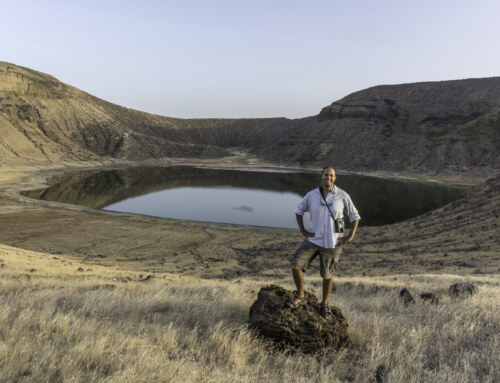Hello again! I’m Ian, and I’m back this week with Owich to talk about the beginning of our last module, Prehistoric Archaeology, taught by Prof. Sonia Harmand.
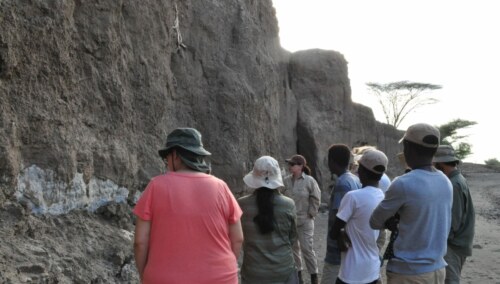
Dr. Sonia Harmand talking the students through the stratigraphy near the Nadung’a sites.
We’re now in our last two weeks here at TBI, and it really feels like time has flown by. On Monday, we started with an introduction to archaeology in Africa and the Turkana Basin, discussing the history of archaeology in East Africa, going back to the excavations by the Leakeys at Olduvai Gorge in the 1930s, and continuing into the modern excavations by the West Turkana Archaeological Project (WTAP). In the afternoon, Prof. Harmand led a discussion on the Early Stone Age (ESA), an area of research she works on. We began with the oldest stone tool technology, the Lomekwian, dated to 3.3 Ma and which marks a new beginning in the archaeological record termed “the dawn of technology.” The Lomekwian tools were discovered at Lomekwi 3 (LOM3) by Sammy Lokorodi, a member of the WTAP team. These tools are simple with large cores and flakes bearing all techno-morphological characteristics of flaked pieces, but nonetheless represent a massive leap forward in technology. Every afternoon after lectures, we meet with Prof. Harmand in the mess area to discuss the day’s readings.
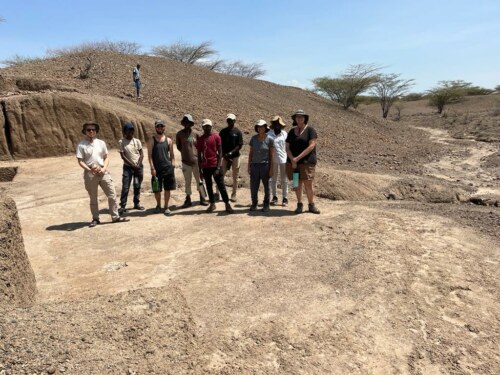
At the Lomekwi 3 excavation site.
On Tuesday, the focus of our discussion was on the Oldowan and the Acheulean industries. The Oldowan industry which dates to ~2.6 Ma and has been well studied as it covers a large geographical and wider time span that exhibits much variability. The Oldowan technology is mainly characterized by flake production. On the other hand, the oldest Acheulean tools were found at Kokiselei 4 in West Turkana, also by the WTAP team, and are dated to 1.76 Ma. The Acheulean industry is characterized by beautifully made hand axes, which are bifacially flaked and ‘teardrop’ in shape. The expertise involved in shaping these tools shows advancement in toolmaking techniques and predetermination of form and symmetry. The following day was spent in class with Prof. Harmand taking us through the Middle Stone Age (MSA) which marks the period from about 250,000 to 50,000 years ago. The MSA hominins focused on the production of blades and points mainly by using prepared core technique. This time period is particularly important as it documents behavioral innovations associated with modern Homo species. Later on, we were introduced to the Later Stone Age (LSA) which dates from about 50,000 to 10,000 years ago. The LSA is characterized by increased manufacture of standardized tools including the microlithics and bladelets. On Thursday, we had a brief lecture in the morning led by Prof. Harmand and the field school director Medina Lubisia, who presented her master’s thesis she has been working on. Medina is Prof. Harmand’s Master student interested in the ESA, and she is particularly looking at Oldowan manuports to understand their relevance in early hominin behaviour. After the lecture, we sorted and packed our excavation equipment ready for the camping trip to the North.
A trip to Nariokotome
Jambo… It’s Amelia, Flor and Patricia writing about our camping trip to Nariokotome.
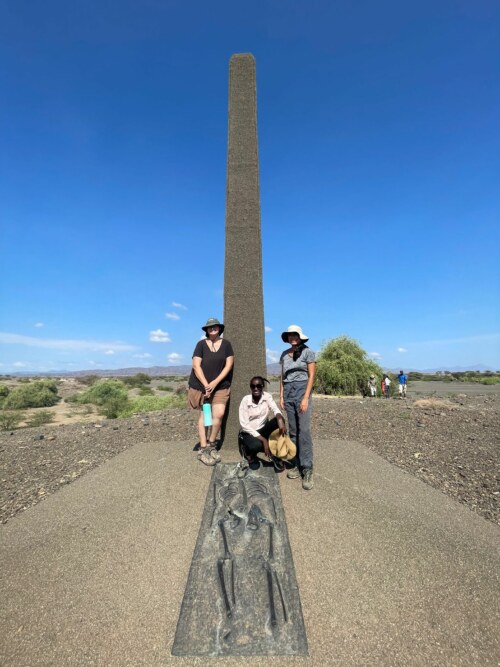
Amelia, Patricia and Flor at the Turkana Boy monument.
We left for Nariokotome on Friday for the five-day camping trip. On our way, we stopped over to visit two important sites. Our first one was at the Kalokol pillar site (Namoratung’a). These Holocene pillars are important to the Turkana community as the locals and even visitors pay homage by placing smaller stones on top of the pillars. Our second stop was at Lomekwi 3, the oldest known archaeological site discovered by a team led by Prof. S. Harmand. On arrival at Nariokotome, Prof. Harmand and Dr. Nicholas Taylor (currently excavating the acheulean sites we were visiting) gave a brief recap of what we’ve been learning in class and how we’re going to apply that in the field. The following day, we headed to the Nadung’a site complex stopping first at the Lower Nariokotome tuff which is dated to 1.5 Ma. We explored different sites within the complex, some of which had been excavated or are under excavation and others that had been recently discovered. At Nadung’a 4, lithic artefacts were found in association with an elephant carcass giving room for functional interpretation of tools within that spatial vicinity. To understand archaeological field methods, we had a great time prospecting and learning how to use the total station and also excavation even though it was hot!
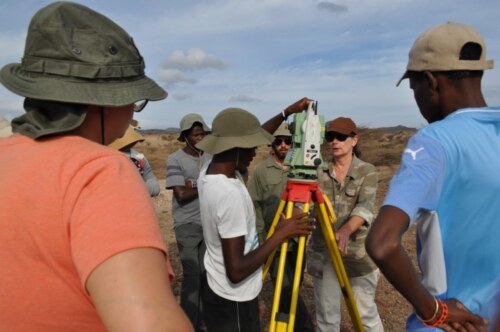
Getting to grips with a total station.
On Sunday we took a short drive from our camp at Nariokotome to visit the monument erected to honor the discovery of Homo ergaster, commonly referred to as “the Nariokotome boy or Turkana boy.” The skeleton of the 13-year-old boy was discovered in 1984 by R. Leakey and K. Kimeu. It was an amazing experience to be able to see the site where the skeleton was excavated. Later that day, we tried our hand at making our own stone tools with Prof. Harmand! We started by collecting different rocks in the near-by laga that we thought would work best for our tool making. Prof. Harmand guided us through the raw material selection process. During the knapping exercise, we found out that the rhyolite raw material was excellent for making sharp, useful flakes. Basalt rocks were best to use as hammerstones since they were very dense and hard to break. We tried the different techniques including bipolar percussion to produce flakes. We also used the freehand percussion technique which required applying a swift, hard strike at an angle while trying to avoid your fingers in the process to produce flakes. I think it was much more difficult than anyone was expecting, but still a very fun technique to try to learn!
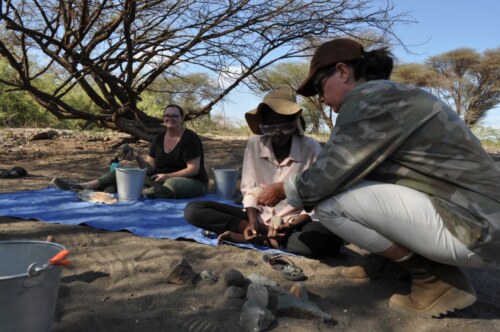
Dr. Sonia Harmand demonstrating knapping techniques.


